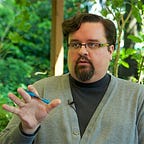Announcing “Access,” a Short Film About Accessibility
Today I released Access, my short documentary about accessibility. It follows Cory Joseph through a typical day, showing how he uses his smartphone, Braille display, tactile watch, and guide dog (named Vine) to navigate the world. I hope you watch it, and I hope it inspires you to make your work more accessible to more people.
I started work on this film in 2015. Yeah, it’s 2019 as I write this. I took my time.
Here’s what happened, short version: I met with a bunch of experts and interviewed them about accessibility in 2015. I wanted to understand the topic deeply, so I collected dozens of hours of footage. I tried to tease apart the related concepts of “accessibility,” “usability,” and “universal design,” and explored the technical effects of these ideas on people who made apps.
I put together a 30-minute cut featuring these interviews and showed it at a conference for accessibility professionals. While the feedback was pretty positive, it was also clear: I had accidentally made a film about accessibility professionals, rather than a film about accessibility itself and the people who benefit from it. Oops.
I wanted to make a film that would raise the consciousness of creative people, and help them understand why accessibility is important. -Chris Higgins
The film I had made was too technical. I wanted to make something simple, clear, and inclusive. So I put all those hours of footage in a drawer and started over. I wanted to make a film that would raise the consciousness of creative people, and help them understand why accessibility is important. I thought the best way to do that would be to show a person using accessible technology.
That’s where Cory Joseph came in. I met him through a friend in the Portland accessibility community. I told Cory that I wanted to follow him around for a day with a camera. I wanted to show what his experience was like, and I wanted him to do all the talking. He was up for it, so that began a series of interviews and shoots around Portland that spanned more than a year. (It turns out “a day” on film was captured over the course of six separate shoots.) I ended up using a small fraction of the footage I captured, but that’s normal for a documentary. At least I was getting the right stuff.
“I’m not asking for something special so that I can use the thing. I’m asking for the thing to be usable or accessible from the get-go.” -Cory Joseph
After I edited the film down to a super-tight twelve minutes, I realized that I was missing something: Audio Description. This is a technique used in many films (though not nearly enough), where a narrator speaks aloud key visual elements of the film that can’t easily be inferred from listening to the audio by itself. I knew about A.D., and I figured I would add it right before I was done, but I hadn’t planned for it properly. I had edited the film so tightly that there was no breathing room left to fit that narration. Oops.
So I stepped back and read as many resources as I could find on how to design a film for Audio Description. I made a second cut of the film, adding space for A.D. narration. I hired Lucy Bellwood, a cartoonist in Portland, to do the narration. Lucy has been working to make her comics more accessible, and also happened to be a terrific narrator. At that stage, I figured I’d have two versions: the “regular” one without A.D., and then this slightly longer one with A.D.
The whole point of the film is that we should create things that are designed, from the start, to be inclusive.
One evening as I was chopping up the film to fit that narration in, I realized how colossally wrong I was. The whole point of the film is that we should create things that are designed, from the start, to be inclusive. As Cory says in the film, “I’m not asking for something special so that I can use the thing. I’m asking for the thing to be usable or accessible from the get-go.” And here I was, carefully designing two versions of that very film, one of which was less accessible than the other. It was all because I thought viewers would be confused or put-off by the “special” A.D. version. I have often been wrong in my life, but this wrongness was particularly painful. Again: oops.
It took me a minute to take Cory’s lesson to heart. Ultimately I decided that there should be only one version of this film, and it should include Audio Description, because that makes the film accessible to a wider audience. I think there’s a lesson for creative people: Even if you think you “get it,” you might not be getting it. Leave room to reconsider. (Try not to leave four years to reconsider, but still.)
It’s about your mindset as a maker. -Chris Higgins
I plan to write more about Access and the lessons I learned while making it over the coming weeks. But for now, it’s finally here and I hope it’s useful to you. It doesn’t matter what you make—whether you’re a writer, a cartoonist, a programmer, a carpenter, a filmmaker, a musician, a painter, an electrician, whatever—the message here is not about technology. It’s about your mindset as a maker. To put it simply, I believe makers have a moral responsibility to make their work accessible to a broad audience. If we’re not actively working to do that, we’re failing our fellow people.
The film is embedded below. There are also alternate versions (a text-only version, an audio-only version, and a downloadable MP4) available at AccessMovie.org, along with more resources about accessibility and universal design.
I’d love to hear what you think. Find me on Twitter or leave a comment here.
